Physical Address
304 North Cardinal St.
Dorchester Center, MA 02124
Most patients who suffer an ankle sprain return to normal sport and daily living activity. However, chronic pain or instability can limit activity and affect up to 20% to 40% of these patients. Ankle impingement syndromes and osteochondral lesions are the leading causes of chronic pain following ankle sprain. Other important causes of painful sprained ankle pain are peroneal tendon injuries (peroneal tendon split syndrome and tendon instability), sinus tarsi syndrome, syndesmotic injuries, subtalar instability, occult fractures, and posttraumatic arthritis.
Ankle impingement syndromes are painful conditions caused by the friction of joint tissues, which is both cause and effect of altered joint biomechanics. The leading causes of impingement lesions are posttraumatic ankle injuries, usually ankle sprains.
These syndromes are classified from the anatomic and clinical viewpoints as anterolateral, anterior, anteromedial, posteromedial, and posterior.
Anterolateral impingement is produced by entrapment of abnormal soft tissue in the anterolateral gutter of the ankle after single or multiple ankle inversion injuries. Approximately 3% of ankle sprains may lead to anterolateral impingement. This type of ankle impingement is most common in athletic young males.
The anterolateral gutter of the ankle is a space bounded anteriorly by the capsule of the tibiotalar joint, the anteroinferior tibiofibular ligament, the anterior talofibular ligament, and the calcaneofibular ligament. Its lateral border is the fibula, and its medial border is the talus and tibia. The space extends inferiorly to the calcaneofibular ligament and superiorly to the tibial plafond and distal tibiofibular syndesmosis.
Anterolateral impingement is thought to occur subsequent to relatively minor trauma involving forced ankle plantar flexion and supination. Such trauma may result in tearing of the anterolateral soft tissues and ligaments without substantial associated mechanical instability. Repeated microtrauma produces synovial scarring, inflammation, and hypertrophy in the anterolateral gutter of the ankle, with subsequent soft tissue impingement ( Fig. 34-1 ). Over time, the reactive soft tissue changes and scarring may organize into a “meniscoid” mass that causes pain and mechanical impingement. Wolin coined the term meniscoid owing to its resemblance at surgery to meniscal tissue.
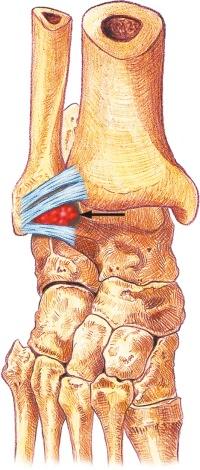
Other contributing factors are hypertrophy of the inferior portion of the anteroinferior talofibular ligament and osseous spurs. First described by Bassett and colleagues, a separate distal fascicle of the anteroinferior talofibular ligament is a common variant. It becomes pathologic when a tear of the anterior talofibular ligament results in anterolateral joint laxity. With increasing joint laxity, the talus extrudes anteriorly in dorsiflexion and comes into contact with the fascicle. Constant rubbing of the fascicle against the talus thickens the fascicle, developing an impinging lesion in the anterolateral gutter. Several authors refer to this condition as syndesmotic impingement.
Patients present with anterolateral ankle tenderness, swelling, and pain exacerbated by single-leg squatting, ankle eversion, or forced dorsiflexion. Despite a lack of true mechanical ligamentous instability, patients may report a subjective sense of ankle instability; this “functional instability” is caused by entrapment of soft tissues at the anterolateral ankle.
Radiographs are used to screen for osteochondral lesions, osteoarthritis, or intraarticular ossicles, which may contribute to chronic ankle pain after an ankle sprain or inversion injury.
Ultrasound can detect scar tissue and synovitis into the lateral gutter. There may be associated increased vascularity on Doppler imaging ( Fig. 34-2 ). Side-to-side comparison is helpful in confirming the abnormality. Posttraumatic ossicles are also well demonstrated by ultrasonography.
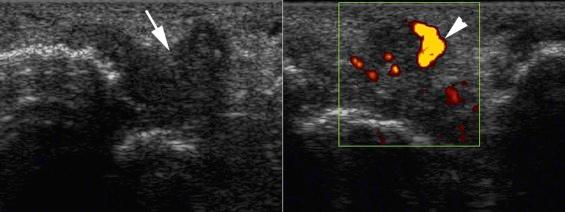
The MRI findings of abnormal soft tissue mass or fibrous band in the anterolateral ankle gutter suggest the diagnosis of anterolateral impingement. Care should be taken not to confuse the frayed margins of the torn anterior talofibular ligament with the meniscoid lesion. Controversies exist about the accuracy of MRI in the diagnosis of anterolateral impingement. Most authors believe that the assessment of the anterolateral recess with conventional MRI is accurate only when a substantial joint effusion is present.
CT arthrography and MR arthrography have been proven as accurate techniques for assessing the presence of soft tissue scarring in the anterolateral recess of the ankle and elucidating its extent in patients with anterolateral impingement before arthroscopy ( Fig. 34-3 ). The absence of a normal fluid-filled recess between the anterolateral soft tissues and the anterior surface of the fibula is another arthrographic finding that suggests the diagnosis of anterolateral impingement. This may be due to the presence of adhesions and scar tissue that impair the entrance of fluid into the normal recess between the fibula and joint capsule. Nevertheless, the identification of abnormal soft tissue itself does not imply the presence of clinical anterolateral impingement because anterolateral scarring and/or synovitis at CT or MR arthrography can be noted in patients without clinical features consistent with those of anterolateral impingement. Therefore, imaging features of anterolateral soft tissue abnormalities must be correlated with clinical findings.
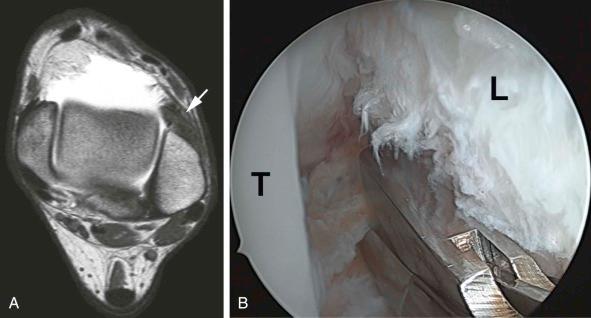
The normal distal fascicle of the anteroinferior talofibular ligament can be readily visualized on MRI and MR arthrography. A distal fascicle causing impingement can be seen as a thickened anteroinferior talofibular ligament and hypertrophic synovial tissue in the superior aspect of the anterolateral gutter (syndesmotic impingement) ( Fig. 34-4 and see Video ![]() ).
).
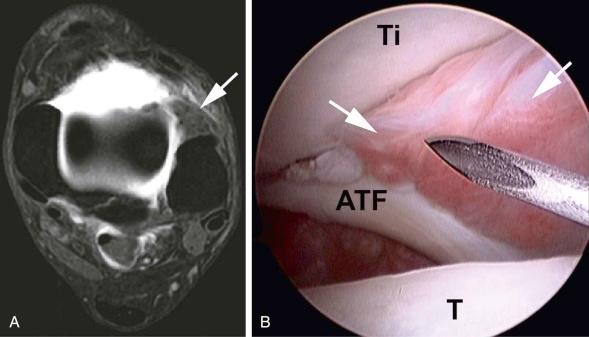
Anterolateral impingement is a diagnosis of exclusion. Lesions producing similar symptoms, including peroneal tendon tears or subluxations, sinus tarsi syndrome, stress fractures, loose bodies, osteochondral lesions, bony impingement, and degenerative joint disease, must be excluded before invasive treatment.
MRI finding of an abnormal soft tissue mass in the anterolateral ankle gutter makes it necessary to exclude conditions such as pigmented villonodular synovitis and idiopathic synovial osteochondromatosis.
Most patients with anterolateral impingement respond to conservative therapy, including nonsteroidal anti-inflammatory drugs, rehabilitative physiotherapy, or local injection of corticosteroids.
In patients with conservative treatment failure, ankle arthroscopy may be performed for débridement of hypertrophic synovial tissue (synovitis and/or scarring) in the anterolateral gutter with good-to-excellent results (see Videos and ![]() ).
).
Anterior osseous impingement due to the formation of anterior tibiotalar spurs is a common cause of chronic ankle pain among athletes, such as soccer players. It is usually the result of impingement with trapping of soft tissues between a beaklike prominence typically formed at the anterior rim of the tibial plafond and the corresponding area over the apposing margin of the talus proximal to the talar neck, well within the anterior ankle joint capsule ( Fig. 34-5 ).
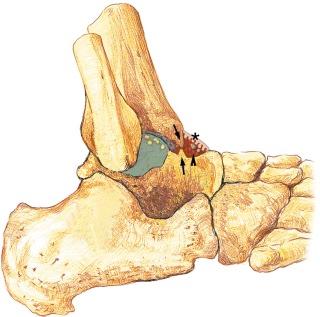
The origin of anterior impingement is uncertain, and many factors are likely involved. Three different hypotheses have been proposed to explain the formation of talotibial spurs in the anterior ankle impingement syndrome.
Forced dorsiflexion results in repeated microtrauma on the tibia and talus, leading to microfractures of trabecular bone or periosteal hemorrhage, healing with new bone formation.
Another mechanism suggested is forced plantarflexion trauma, with capsular avulsion injury. However, most talotibial spurs are not located at the capsular attachment, and this hypothesis for the formation of traction spurs is therefore plausible in only a minority of cases. A recent hypothesis suggested that formation of bony spurs in the ankle is related to direct damage to the rim of the anterior ankle cartilage by repetitive kicking actions.
Once formed, forced dorsiflexion of the ankle causes impingement between reciprocating talotibial “kissing” lesions.
Affected individuals present with pain, stiffness, swelling, and limitation of ankle dorsiflexion. Symptoms are exacerbated by athletic activity. However, these changes are very common in asymptomatic athletic populations and require no treatment.
Conventional radiography is the only imaging study required in most cases, allowing evaluation of osseous spurs and the tibiotalar joint space.
Become a Clinical Tree membership for Full access and enjoy Unlimited articles
If you are a member. Log in here